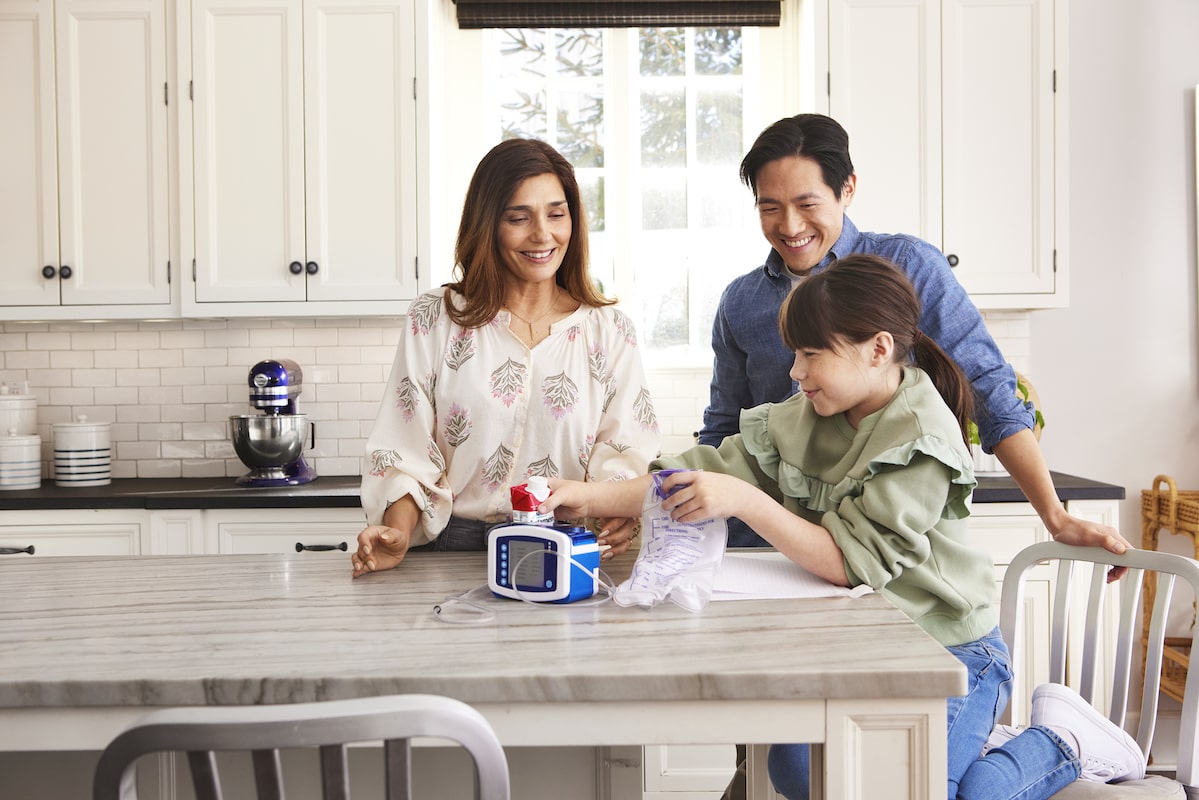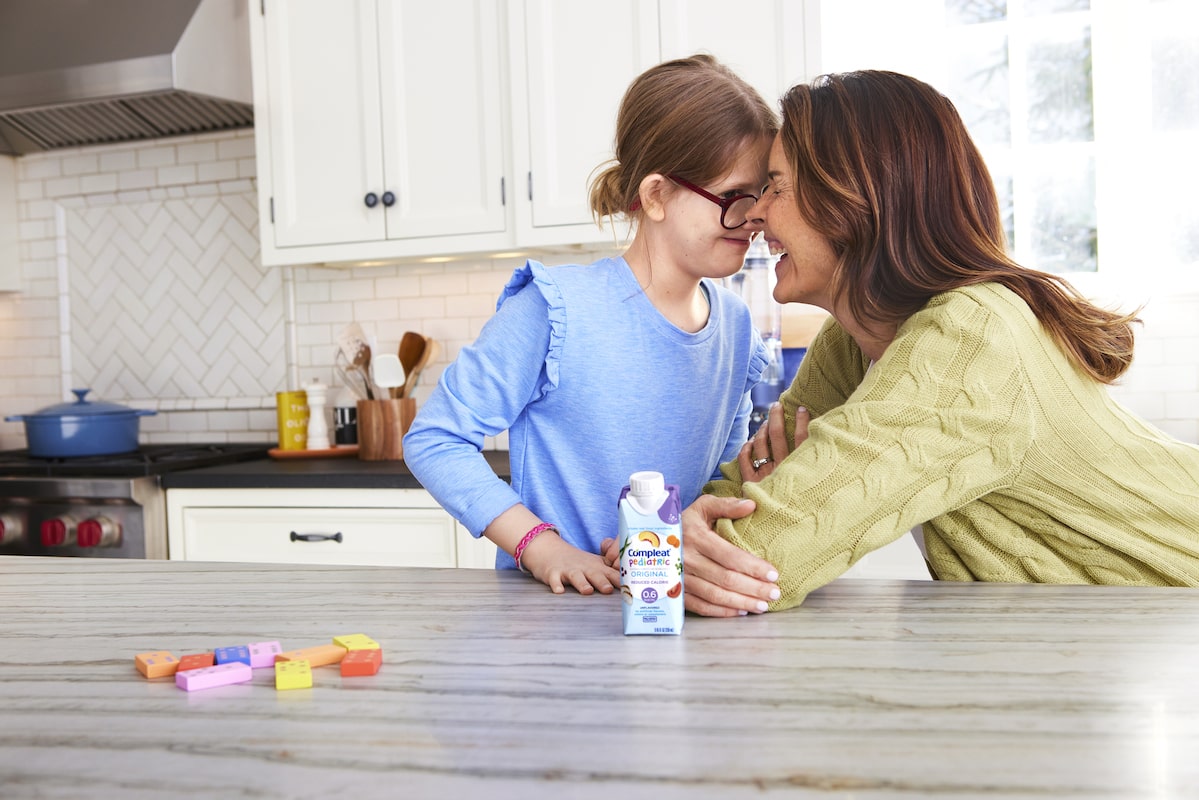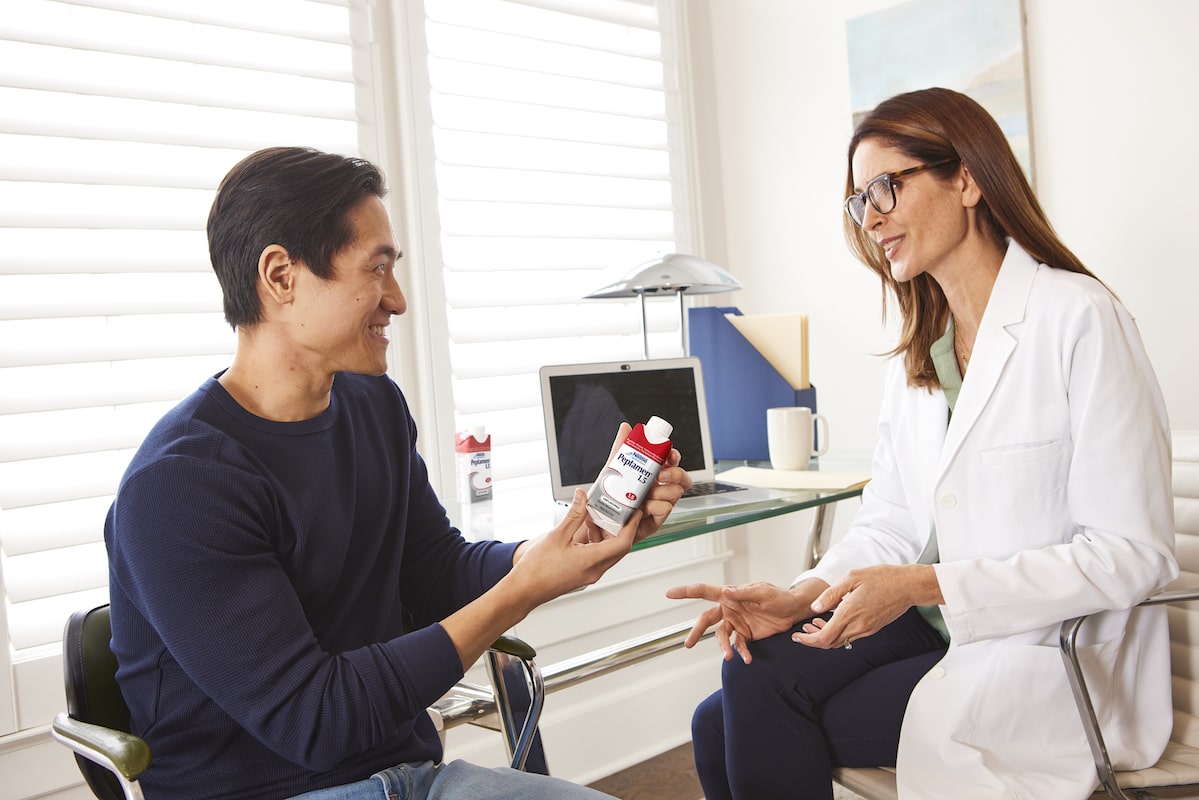It’s good to be home
As you or your loved one adjusts to being home, know that we’re here for you. With these easy-to-follow instructions you will understand how to manage your nutritional requirements and make sure you get the nourishment you need to grow, heal and thrive.
To meet your nutritional needs, your doctor has prescribed home enteral nutrition—commonly known as home tube feeding. Enteral is another word for stomach and intestines. Enteral nutrition means that a liquid, nutrient-rich formula flows gently through a special tube into your stomach or intestine.
Enteral nutrition is very important when you are not able to eat or digest food normally. Just like regular food, your tube feeding will provide all the essential nutrients—calories, protein, carbohydrates, fats, vitamins and minerals.


Managing Your Tube Feeding
This section includes guidelines on how to administer a tube feeding, as well as information on feeding schedules, providing additional water, and administering medications. Please be sure to check with your healthcare team for specific step-by-step instructions.
Checking the placement of your feeding tube
If your healthcare professional has instructed you to check the position of your tube before you begin a feeding, follow these instructions:
- Wash your hands thoroughly with soap and water
- For a nasogastric or nasojejunal tube, check the proper tube position as instructed by your healthcare professional (there may be a special mark drawn on the tube or a certain length it should be from the end of your nose).
- For a gastrostomy or jejunostomy tube use a ruler or non-stretchable tape measure to measure the number of inches from the site where your tube exits your skin to the end of the tube (as pictured).
- Compare the number with previous measurements. If there is greater difference between measurements than advised by your healthcare professional, give them a call and do not begin the feeding.
Flushing Your Feeding Tube
To keep your feeding tube clean and prevent clogging, flush your tube with water several times a day or as directed by your healthcare professional. Flush your tube before and after giving medications and before and after giving formula. Your healthcare professional will prescribe how much water you should receive.
Follow the steps below to flush your tube:
- Fill a clean measuring cup with lukewarm water (Avoid using cold water as this can cause cramping).
- Using a 60 mL syringe*, put the tip of the syringe in the water and draw up the prescribed amount of water into the syringe.
- Open (uncap) your feeding tube or feeding tube extension and attach the syringe.
- Gently push on the plunger to flush with the prescribed amount of water, as directed by your healthcare professional.
- Close (recap) feeding tube or feeding tube extension when flush is complete.
Measuring gastric residual
If you have a nasogastric or gastrostomy tube and are feeling nauseated or bloated, your healthcare professional may suggest that before each feeding you check to see if there is still some formula in your stomach. This is called the “gastric residual.” Talk with your healthcare professional for specific instructions on how to check the gastric residual.
Note: There should be little or no residual when a jejunostomy tube is in place, so it is not necessary to check residual.
Proper Positioning
Proper positioning during your feeding is important to help reduce the risk of aspiration which can occur if your tube feeding formula gets into your lungs. During your feeding, sit or lie with your head elevated at least 30 degrees (about the height of two pillows) and remain in this position for 30 to 60 minutes after each feeding to help prevent nausea or reflux. If you are on continuous feedings, your head must remain elevated at least 30 degrees at all times.
Hang Time
If receiving tube feeding using a feeding pump, limit how long you let your formula stay at room temperature, often referred to as “hang time”. To reduce the risk of bacterial contamination, fill your feeding bag with only enough liquid formula for an 8 hour “hang time”. If using a powdered formula that is mixed with water, fill your feeding bag with just enough formula for a 4 hour “hang time”. When your “hang time” has expired, rinse your feeding bag and tubing before adding fresh formula. Never add new formula to a bag with existing formula.
Formula Safety and Storage
Store your supplies and unopened formula in a cool, dry place out of direct sunlight, such as in your pantry. Reclose or tightly cover and refrigerate any unused opened tube feeding formula for up to 24 hours before discarding. Always check the expiration date before using.
* Or appropriate size syringe directed by your healthcare professional.
Tube feeding schedules
In order to provide the nutrition you need, this schedule for your tube feeding and water flushes has been developed by your healthcare professional. Download your tube feeding schedule template here.
Syringe feeding
Your tube feeding formula is _____________________ Use _________ cartons per day or __________ mL per day. Deliver syringe feedings ________ times each day. Example feeding times: _______________________ Each of your syringe feedings should include _________ carton(s) or _________ mL of formula.
Before each feeding, flush your tube with __________ mL of lukewarm water, using a 60 mL syringe*.
After each feeding, flush your tube with __________ mL of lukewarm water, again using a 60 mL syringe*. You will need an additional ________ mL of free water per day.
Gravity feeding
Your tube feeding formula is ______________________________. You will use _________ cartons per day or _________ mL per day. Deliver your gravity feedings _________ times each day. Example feeding times: ________________________________ Each of your gravity feedings should include _________ carton(s) or _________ mL of formula.
Before each gravity feeding, flush your tube with _________ mL of lukewarm water, using a 60 mL syringe*.
After each gravity feeding, flush your tube with _________ mL of lukewarm water, again using a 60 mL syringe*. You will need an additional _________ mL of free water per day.
Pump feeding
Your tube feeding formula is ________________________________.
Your total daily feeding should equal ______________ cartons or _________ mL of formula.
Your goal pump flow rate is _________ mL per hour, for ______ hours per day.
Your feeding should be taken from ______AM/PM to_____ AM/PM.
As you become more familiar with your feedings, you may want to vary the feeding times. Check with your healthcare professional.
If using a pump that offers a separate bag to deliver water for hydration, fill your water bag with _________ mL of water. Your flush rate is _________ mL every ______ hours.
If NOT using a pump that offers a separate bag to deliver water for hydration, flush your tube with _________ mL of water, using a 60 mL syringe* _______ times per day.
Regardless of feeding system, you should flush your tube with _________ mL at start and stop of pump feedings to help keep your tube from clogging.
To assure adequate fluid intake, a total of _________ mL of lukewarm water should be delivered each day in addition to the formula.
* Or appropriate size syringe directed by your healthcare professional.
Storage and Handling of Tube Feeding Formulas
It is important to store formula properly. Formula is like food and can cause illness if it is not handled or stored properly.
- Store unopened formula in a clean, dry place at room temperature.
- If only part of a container of formula is used, cover it with plastic wrap, label it with the date and time it was opened, and put it in the refrigerator.
- Use it within 24 hours of opening it. If not used in 24 hours, throw it out.
- To avoid an upset stomach, take formula out of the refrigerator 30 minutes before using and leave covered with plastic wrap.
- Do not heat formula in a microwave or on a stovetop.
When to Call a Healthcare Professional
Home tube feeding presents a new set of procedures and responsibilities for you and your family. It is only natural to have questions, or to need some help, once you are home. Your healthcare professional can help you answer questions such as:
- What to expect from the tube feeding experience and the different tube feeding options available.
- What type of equipment is needed and how to set it up.
- How to know if you are getting enough nutrition.
Contact your healthcare team if you have any questions about any part of your home tube feeding plan, including how you are tolerating your tube feeding, if you are having any problems, or if you have questions about your formula.
Your healthcare team is there for you, to make sure that your home tube feeding experience is as comfortable and problem-free as possible.
When to Contact your Healthcare Provider:
If you are having problems with how your feeding tube is working, contact your health care provider. Problems with the Feeding Tube include:
- Tube is clogged: Formula will not flow smoothly through the tube and you have checked the tube for kinks or bends and flushed the tube with water
- Tube moves in or out more than 1 inch
- Tube falls out
- Large amounts of fluid leaking around the tube (dressing is soaked more than once a day)

If there is change in your health (like a fever or diarrhea) that has you worried, contact your healthcare provider. Changes that may signal an infection, feeding intolerance, or other health problems:
- Skin area around tube has signs of infection
- Reddened area
- Warm to touch
- Firm to touch
- Tender
- More drainage than usual
- Drainage that smells bad
- Bloody or coffee-ground-colored drainage from the tube
- A sudden increase or decrease in the amount of drainage through the tube
- Nausea and/or vomiting that does not go away
- Fever of 101 degrees or higher
- Unusual and/or sudden weight loss or gain (more than two pounds a day)
- Constipation: No stools for two days or stools that are difficult to pass
- Diarrhea: Four or more loose or watery stools a day
- Stomach becomes bloated or distended and tight
Talk with your healthcare professional to see if a Nestlé Health Science formula is right for you. The content on this website is for educational purposes only and should not be considered to be medical advice. It is not intended to replace the advice of your healthcare team. Please consult your healthcare team with any questions about the appropiate nutition and delivery of you or your child's nutrition.
